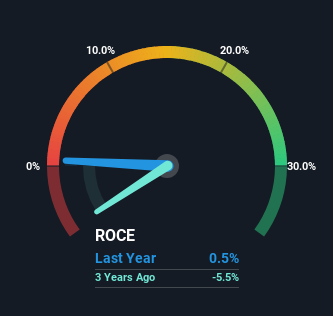- United Kingdom
- /
- Hospitality
- /
- AIM:PIER
Be Wary Of Brighton Pier Group (LON:PIER) And Its Returns On Capital
Finding a business that has the potential to grow substantially is not easy, but it is possible if we look at a few key financial metrics. In a perfect world, we'd like to see a company investing more capital into its business and ideally the returns earned from that capital are also increasing. Ultimately, this demonstrates that it's a business that is reinvesting profits at increasing rates of return. Although, when we looked at Brighton Pier Group (LON:PIER), it didn't seem to tick all of these boxes.
Return On Capital Employed (ROCE): What Is It?
Just to clarify if you're unsure, ROCE is a metric for evaluating how much pre-tax income (in percentage terms) a company earns on the capital invested in its business. To calculate this metric for Brighton Pier Group, this is the formula:
Return on Capital Employed = Earnings Before Interest and Tax (EBIT) ÷ (Total Assets - Current Liabilities)
0.0051 = UK£251k ÷ (UK£60m - UK£11m) (Based on the trailing twelve months to June 2024).
So, Brighton Pier Group has an ROCE of 0.5%. Ultimately, that's a low return and it under-performs the Hospitality industry average of 7.5%.
See our latest analysis for Brighton Pier Group

Historical performance is a great place to start when researching a stock so above you can see the gauge for Brighton Pier Group's ROCE against it's prior returns. If you'd like to look at how Brighton Pier Group has performed in the past in other metrics, you can view this free graph of Brighton Pier Group's past earnings, revenue and cash flow.
What Does the ROCE Trend For Brighton Pier Group Tell Us?
On the surface, the trend of ROCE at Brighton Pier Group doesn't inspire confidence. To be more specific, ROCE has fallen from 9.6% over the last five years. And considering revenue has dropped while employing more capital, we'd be cautious. If this were to continue, you might be looking at a company that is trying to reinvest for growth but is actually losing market share since sales haven't increased.
What We Can Learn From Brighton Pier Group's ROCE
In summary, we're somewhat concerned by Brighton Pier Group's diminishing returns on increasing amounts of capital. Long term shareholders who've owned the stock over the last five years have experienced a 56% depreciation in their investment, so it appears the market might not like these trends either. Unless there is a shift to a more positive trajectory in these metrics, we would look elsewhere.
One more thing: We've identified 3 warning signs with Brighton Pier Group (at least 1 which is concerning) , and understanding these would certainly be useful.
While Brighton Pier Group may not currently earn the highest returns, we've compiled a list of companies that currently earn more than 25% return on equity. Check out this free list here.
Valuation is complex, but we're here to simplify it.
Discover if Brighton Pier Group might be undervalued or overvalued with our detailed analysis, featuring fair value estimates, potential risks, dividends, insider trades, and its financial condition.
Access Free AnalysisHave feedback on this article? Concerned about the content? Get in touch with us directly. Alternatively, email editorial-team (at) simplywallst.com.
This article by Simply Wall St is general in nature. We provide commentary based on historical data and analyst forecasts only using an unbiased methodology and our articles are not intended to be financial advice. It does not constitute a recommendation to buy or sell any stock, and does not take account of your objectives, or your financial situation. We aim to bring you long-term focused analysis driven by fundamental data. Note that our analysis may not factor in the latest price-sensitive company announcements or qualitative material. Simply Wall St has no position in any stocks mentioned.
About AIM:PIER
Brighton Pier Group
Operates leisure and entertainment assets in the United Kingdom.
Slight and slightly overvalued.
Similar Companies
Market Insights
Community Narratives



